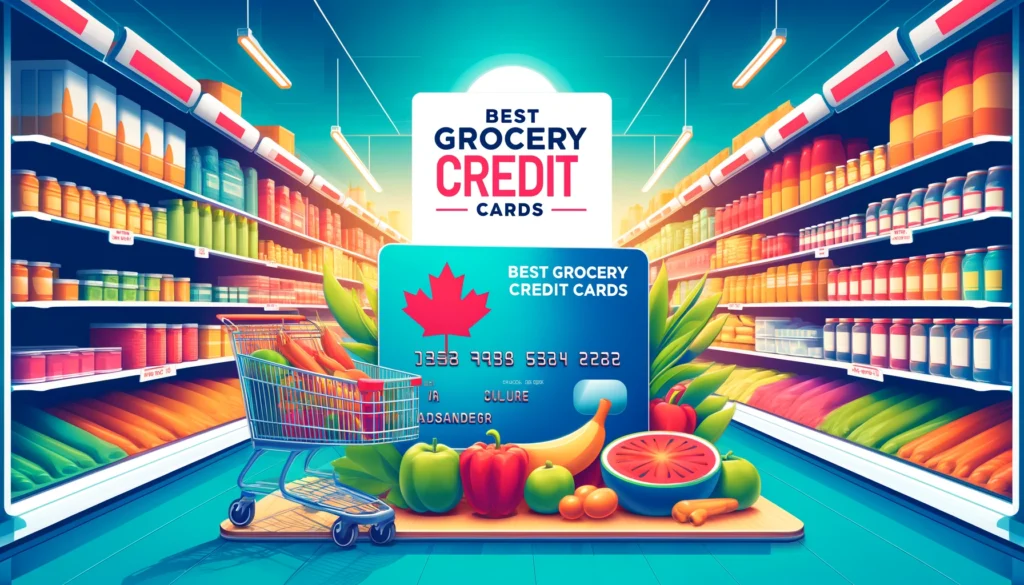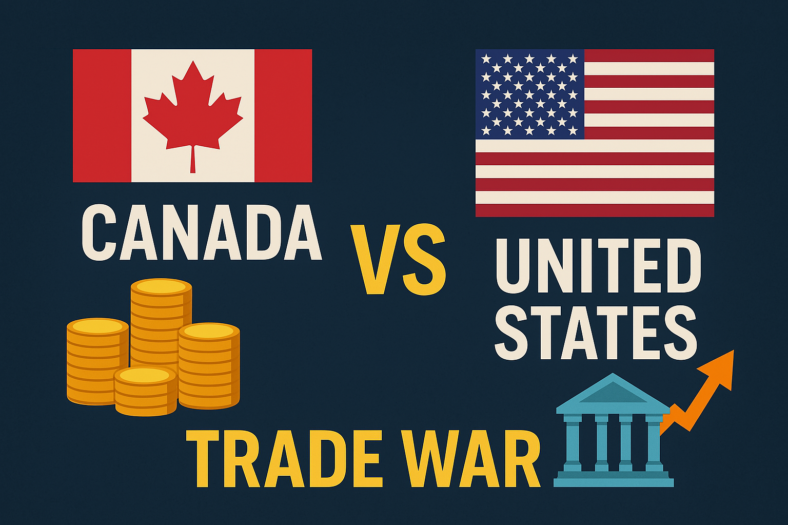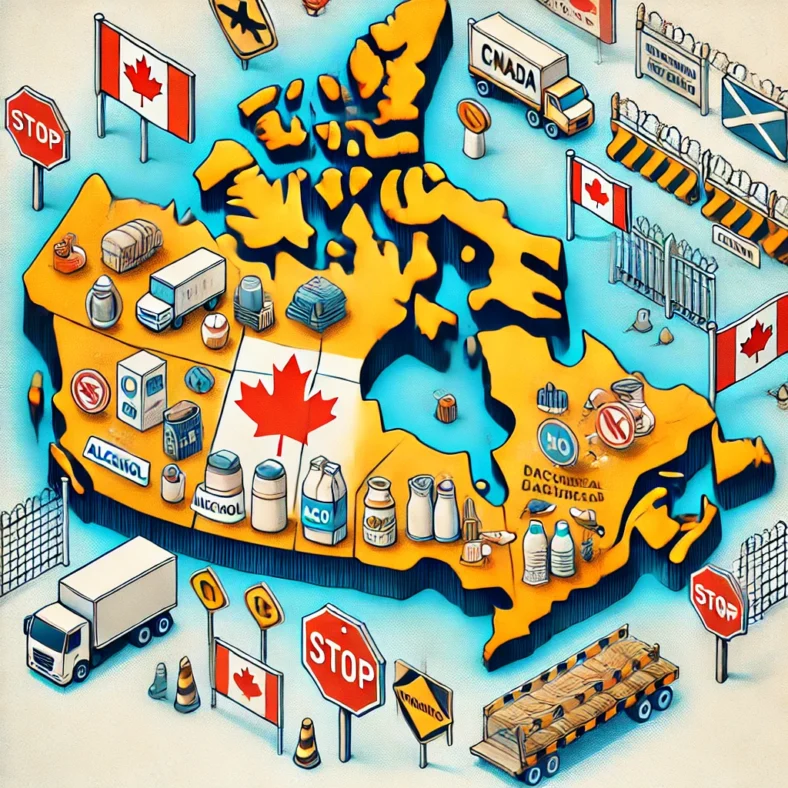When it comes to grocery shopping, Canadians are no strangers to the routine of stocking up their pantries with essentials. Whether it’s a weekly trip to the neighborhood supermarket or a larger haul at specialty stores, the expenditure on groceries is a significant part of household budgets. Understanding this consumer behavior, financial institutions have introduced a range of credit cards designed to maximize benefits and rewards for those very purchases. From cashback incentives to bonus points, these cards offer enticing perks that can translate into tangible savings over time.
In this comprehensive guide, we embark on a journey to explore the best grocery credit cards available in Canada. Through detailed analysis and comparison, we aim to equip you with the knowledge needed to make an informed decision tailored to your spending habits and lifestyle preferences. Whether you’re a seasoned rewards aficionado or a newcomer to the world of credit cards, there’s something for everyone in this exploration of the top contenders in the realm of grocery rewards. So, without further ado, let’s dive into the world of grocery credit cards and unlock the potential for savings and rewards that await savvy Canadian consumers.
Best Grocery Credit Cards in Canada – Our Top Picks
| Compare | Ratestead Rating | Annual Fee | Annual Rewards | Welcome Bonus | Learn More |
|---|
| APPLY NOW | /10 |
How do grocery credit cards work?
Grocery credit cards operate on a simple premise: they offer rewards, incentives, or cashback specifically tailored to grocery purchases made by cardholders. Here’s a breakdown of how these cards typically function:
Reward Structure: Most grocery credit cards offer rewards in the form of cashback, points, or miles for every dollar spent on eligible grocery purchases. These rewards can vary significantly among different cards, with some offering higher rates for grocery spending compared to other categories.
Eligible Merchants: To qualify for rewards, cardholders must make purchases at eligible grocery stores, supermarkets, and sometimes even specialty food stores. It’s essential to review the card’s terms and conditions to understand which merchants qualify for rewards.
Earning Rewards: Cardholders accumulate rewards with each eligible grocery purchase they make using the credit card. The rewards earned are typically credited to the cardholder’s account either monthly or at the end of each billing cycle.
Redemption Options: Depending on the card, accumulated rewards can be redeemed for various options, including statement credits, gift cards, merchandise, travel, or even transferred to partner loyalty programs. Some cards may offer more flexibility in redemption options than others.
Additional Benefits: In addition to grocery rewards, many credit cards may offer supplementary benefits such as extended warranty protection, purchase protection, and sometimes even insurance coverage on purchases made with the card.
Annual Fees and Interest Rates: It’s essential to consider any annual fees associated with the credit card, as well as the interest rates charged on balances carried over from month to month. While some grocery credit cards may have no annual fee, others may offer enhanced rewards at the expense of an annual fee.
Optimizing Rewards: To maximize the benefits of a grocery credit card, cardholders should strategically use the card for their grocery purchases while using other cards for different spending categories. Additionally, taking advantage of sign-up bonuses, promotional offers, and utilizing any bonus categories can further enhance rewards accumulation.
Overall, grocery credit cards offer a straightforward way for consumers to earn rewards and savings on their everyday grocery purchases. By understanding how these cards work and choosing the right one based on individual spending habits and preferences, cardholders can unlock significant value and enjoy the perks of grocery rewards.
Pros and cons of grocery credit cards
Pros:
Enhanced Rewards: Grocery credit cards typically offer higher rewards, cashback, or points for purchases made at grocery stores compared to other spending categories. This allows cardholders to maximize their rewards and earn significant savings on essential household expenses.
Tailored Benefits: Many grocery credit cards come with additional perks and benefits specifically designed for grocery shoppers. These may include discounts, freebies, or bonus rewards at participating grocery stores, enhancing the overall value proposition of the card.
Savings on Everyday Expenses: Since groceries are a recurring expense for most households, using a grocery credit card can result in substantial savings over time. Cardholders can earn rewards on their everyday purchases, effectively reducing their grocery bills or accumulating points for future redemption.
Flexibility in Redemption: Depending on the card, accumulated rewards can often be redeemed for a variety of options, including statement credits, gift cards, travel, merchandise, or even charitable donations. This flexibility allows cardholders to choose rewards that best suit their preferences and financial goals.
Additional Perks: In addition to grocery rewards, many credit cards offer supplementary benefits such as extended warranty protection, purchase protection, travel insurance, and access to exclusive events or experiences. These perks can add significant value to the cardholder’s overall financial toolkit.
Cons:
Annual Fees: Some grocery credit cards may come with annual fees, which can eat into the overall value of the rewards earned, especially for consumers who don’t spend a significant amount on groceries. It’s essential to weigh the benefits against the cost of the annual fee to determine if the card is worthwhile.
Higher Interest Rates: Like most rewards credit cards, grocery credit cards often come with higher interest rates compared to standard credit cards. Carrying a balance from month to month can incur substantial interest charges, negating the benefits of any rewards earned.
Limited Bonus Categories: While grocery credit cards excel in rewarding grocery purchases, they may offer lower rewards or no rewards at all for other spending categories. This can limit the overall utility of the card for consumers who spend less on groceries relative to other expenses.
Redemption Restrictions: Some grocery credit cards may impose restrictions or limitations on reward redemption, such as minimum redemption thresholds, blackout dates for travel rewards, or restrictions on transferring points to partner loyalty programs. Understanding these limitations is crucial to maximizing the value of accrued rewards.
Temptation to Overspend: The allure of earning rewards on grocery purchases may tempt some cardholders to overspend or purchase unnecessary items to reach spending thresholds for bonus rewards. It’s essential to maintain disciplined spending habits and prioritize needs over wants to avoid accumulating debt.
In conclusion, grocery credit cards offer a range of benefits for consumers who prioritize savings and rewards on their grocery purchases. However, it’s essential to weigh the pros and cons carefully and choose a card that aligns with individual spending habits, financial goals, and lifestyle preferences. By understanding the nuances of grocery credit cards and using them responsibly, cardholders can maximize their rewards and enjoy significant savings on their everyday expenses.
What types of grocery credit cards are available in Canada
Cashback Credit Cards: Cashback credit cards offer a percentage of the amount spent on groceries as cashback rewards. These cards provide straightforward rewards that can be redeemed as statement credits or deposited into the cardholder’s bank account. Some cashback cards may offer higher cashback rates specifically for grocery purchases, making them attractive options for those who prioritize simplicity and flexibility.
Points Rewards Credit Cards: Points rewards credit cards allow cardholders to earn points for every dollar spent on groceries. These points can be accumulated and redeemed for various rewards, including travel, merchandise, gift cards, and more. Some points rewards cards may offer bonus points or accelerated earnings rates for grocery spending, providing additional incentives for cardholders.
Co-branded Credit Cards: Co-branded credit cards are offered in partnership between a credit card issuer and a specific grocery retailer or chain. These cards typically offer enhanced rewards, discounts, or exclusive benefits when used for purchases at the partnering grocery store. Co-branded cards may also offer rewards for spending in other categories, but their primary focus is on rewarding grocery purchases.
Flexible Rewards Credit Cards: Flexible rewards credit cards allow cardholders to earn points or miles that can be redeemed for a variety of rewards, including groceries. These cards offer versatility in redemption options, allowing cardholders to use their rewards for travel, merchandise, gift cards, statement credits, and more. While flexible rewards cards may not offer specialized rewards for grocery spending, they provide flexibility and choice in how rewards are redeemed.
Premium Rewards Credit Cards: Premium rewards credit cards cater to high-spending consumers and offer an array of benefits, including elevated rewards rates for grocery purchases. These cards often come with high annual fees but provide generous rewards, premium perks such as airport lounge access, travel credits, concierge services, and comprehensive insurance coverage. Premium rewards cards may appeal to frequent travelers or individuals seeking luxury benefits alongside grocery rewards.
No Annual Fee Credit Cards: Some credit cards offer rewards for grocery spending without charging an annual fee. These cards provide a cost-effective way for consumers to earn rewards on their grocery purchases without committing to ongoing fees. While the rewards rates may be lower compared to cards with annual fees, they still offer value for budget-conscious shoppers.
Overall, the variety of grocery credit cards available in Canada caters to diverse preferences and spending habits. Whether you prioritize cashback, points, co-branded benefits, flexibility, premium perks, or no annual fees, there’s a grocery credit card suited to your needs and lifestyle. By understanding the different types of cards and their respective features, consumers can make informed decisions and choose the card that best aligns with their financial goals and preferences.
Finding and Choosing the Best Grocery Credit Cards in Canada:
Assess Your Spending Habits
Before diving into the world of grocery credit cards, take a moment to analyze your spending habits. Determine how much you typically spend on groceries each month and identify any other significant spending categories. Understanding your spending patterns will help you narrow down credit card options that align with your lifestyle and priorities.
Research Available Options
Conduct thorough research to explore the various grocery credit cards available in Canada. Utilize online resources, comparison websites, and financial institutions’ websites to gather information about the features, rewards, fees, and benefits offered by different cards. Pay attention to factors such as cashback rates, points earning potential, redemption options, annual fees, and any promotional offers or sign-up bonuses.
Compare Rewards Structures
Compare the rewards structures of different grocery credit cards to determine which one offers the best value for your spending habits. Look for cards that offer competitive rewards rates specifically for grocery purchases, as well as any bonus categories or additional benefits that may enhance the overall value proposition of the card.
Consider Annual Fees
Evaluate whether the potential rewards and benefits outweigh the cost of any annual fees associated with the credit card. While some grocery credit cards may come with no annual fee, others may offer higher rewards rates or premium perks in exchange for an annual fee. Calculate the net value of rewards earned after deducting the annual fee to ensure the card is cost-effective for your budget.
Review Redemption Options
Examine the redemption options available with each credit card to ensure they align with your preferences and lifestyle. Some cards may offer flexible redemption options, allowing you to redeem rewards for statement credits, gift cards, travel, merchandise, or even charitable donations. Choose a card that offers redemption options that best suit your needs and preferences.
Evaluate Additional Benefits
Consider any additional benefits or perks offered by the credit card, such as purchase protection, extended warranty coverage, travel insurance, or access to exclusive events or experiences. These supplementary benefits can add significant value to the card and enhance your overall cardholder experience.
Read Reviews and Customer Feedback
Take the time to read reviews and customer feedback about the grocery credit cards you’re considering. Pay attention to the experiences of other cardholders, including any potential drawbacks or issues they’ve encountered with the card. This firsthand insight can provide valuable information to help you make an informed decision.
Apply for the Card
Once you’ve identified the best grocery credit card that meets your criteria, proceed with the application process. Complete the application form accurately and provide any required documentation or information. Keep in mind that approval criteria may vary depending on the issuer’s policies and your creditworthiness.
Use the Card Responsibly
Upon receiving your grocery credit card, use it responsibly to maximize rewards and benefits while avoiding unnecessary debt. Make regular payments on time, stay within your budget, and prioritize needs over wants when making purchases. By using the card responsibly, you can enjoy the rewards and benefits it offers while maintaining financial stability.
By following these steps, you can effectively find and choose the best grocery credit card in Canada that aligns with your spending habits, preferences, and financial goals. Remember to periodically review your card’s features and compare it with other options in the market to ensure you’re maximizing your rewards and getting the most value out of your credit card.
Common interest rates, fees and costs for grocery credit cards in Canada
Annual Percentage Rate (APR): The APR represents the interest rate charged on balances carried over from month to month. The APR for grocery credit cards in Canada typically ranges from around 19% to 25%, although it can vary depending on factors such as the card issuer, cardholder’s creditworthiness, and prevailing market conditions. It’s essential to pay attention to the APR to understand the cost of carrying a balance on the card and to make informed decisions about borrowing.
Annual Fees: Annual fees are charges imposed by credit card issuers for the privilege of holding the card. Grocery credit cards in Canada may come with annual fees ranging from $0 to $150 or more, depending on the card’s features, rewards, and benefits. Some cards waive the annual fee for the first year as a promotional offer, while others may require payment of the fee upfront or annually. It’s important to consider the annual fee in relation to the card’s rewards and benefits to assess its overall value.
Foreign Transaction Fees: Foreign transaction fees are charges applied to purchases made in foreign currencies or processed by foreign merchants. While not directly related to grocery purchases, it’s important to be aware of foreign transaction fees if you frequently travel or make purchases from international retailers. Foreign transaction fees typically range from 2% to 3% of the transaction amount, although some cards may waive this fee entirely.
Balance Transfer Fees: Balance transfer fees are charges incurred when transferring balances from one credit card to another. While balance transfers are not directly related to grocery purchases, some cardholders may use this feature to consolidate debt or take advantage of promotional balance transfer offers. Balance transfer fees typically range from 1% to 5% of the transferred amount, with a minimum fee applied.
Late Payment Fees: Late payment fees are charges assessed when cardholders fail to make the minimum payment by the due date. Late payment fees for grocery credit cards in Canada typically range from $25 to $40 per occurrence. Additionally, late payments can also result in penalties such as increased interest rates and negative impacts on the cardholder’s credit score.
Overlimit Fees: Overlimit fees are charges incurred when cardholders exceed their credit limit. While some credit cards allow transactions to be approved beyond the credit limit, overlimit fees may apply in such cases. Overlimit fees for grocery credit cards in Canada typically range from $25 to $40 per occurrence.
Cash Advance Fees: Cash advance fees are charges applied when cardholders obtain cash advances from their credit card, such as withdrawing cash from an ATM or obtaining cash equivalents. Cash advance fees for grocery credit cards in Canada typically range from 1% to 5% of the cash advance amount, with a minimum fee applied. Additionally, cash advances may also incur higher interest rates compared to regular purchases.
Overall, it’s essential for cardholders to carefully review the terms and conditions of their grocery credit cards to understand the applicable interest rates, fees, and costs. By being aware of these factors, cardholders can make informed decisions about their credit card usage and effectively manage their finances.
Alternatives to grocery credit cards
Cashback Apps: Cashback apps offer a simple and convenient way to earn rewards on grocery purchases without the need for a specific credit card. These apps allow users to upload receipts from grocery purchases and receive cashback or rewards points for eligible items. Popular cashback apps in Canada include Ibotta, Checkout 51, and Caddle.
Retailer Loyalty Programs: Many grocery retailers offer their own loyalty programs that reward customers for their purchases. These programs typically allow customers to earn points or discounts on groceries and other items, which can be redeemed for future purchases. Examples include PC Optimum (Loblaws, Shoppers Drug Mart, etc.), AIR MILES (Sobeys, Metro, etc.), and More Rewards (Save-On-Foods, Overwaitea Food Group).
Membership Warehouse Clubs: Membership warehouse clubs like Costco and Sam’s Club offer bulk discounts on groceries and other household items to members. While not technically a credit card, membership at these clubs can provide significant savings for frequent grocery shoppers. Additionally, some warehouse clubs offer co-branded credit cards that provide additional benefits and rewards for purchases made at the club.
Debit Card Rewards Programs: Some banks offer debit card rewards programs that allow customers to earn points or cashback on purchases made with their debit cards. While not as common as credit card rewards programs, these programs can still provide value for consumers who prefer to use debit for their transactions. Examples include RBC Rewards Debit, TD Debit Rewards, and Scotiabank SCENE Debit.
Cash Envelope System: The cash envelope system is a budgeting method where consumers allocate a set amount of cash for specific spending categories, including groceries. By using cash for grocery purchases, individuals can better control their spending and avoid overspending. While this method doesn’t offer rewards like credit cards, it can help individuals stick to their budget and avoid accumulating debt.
High-Interest Savings Accounts: Some financial institutions offer high-interest savings accounts that provide competitive interest rates on deposited funds. By depositing money into these accounts and earning interest, individuals can indirectly offset the cost of their grocery purchases over time. While not a direct alternative to credit cards, high-interest savings accounts can provide a way to grow savings while still meeting everyday expenses.
Meal Planning and Budgeting: Implementing meal planning and budgeting strategies can help individuals reduce their grocery expenses and make more informed purchasing decisions. By planning meals in advance, creating shopping lists, and sticking to a budget, individuals can optimize their grocery spending and avoid unnecessary purchases. While not a rewards program per se, effective meal planning can result in significant savings over time.
Ultimately, the best alternative to grocery credit cards depends on individual preferences, spending habits, and financial goals. By exploring different options and considering factors such as rewards, convenience, and cost-effectiveness, consumers can find the approach that works best for them.
FAQs about the best grocery credit cards in Canada
A grocery credit card is a type of credit card that offers rewards, cashback, or incentives specifically tailored to grocery purchases. These cards typically provide enhanced rewards rates for spending at grocery stores, supermarkets, and sometimes even specialty food retailers.
Grocery credit cards work by rewarding cardholders with cashback, points, or other incentives for purchases made at eligible grocery merchants. Cardholders earn rewards based on their spending, which can then be redeemed for various rewards, such as statement credits, gift cards, merchandise, or travel.
The benefits of using a grocery credit card include earning rewards or cashback on grocery purchases, maximizing savings on essential household expenses, and accessing additional perks and benefits such as extended warranty protection, purchase protection, and travel insurance.
To choose the best grocery credit card for your needs, consider factors such as rewards rates, redemption options, annual fees, additional benefits, and your spending habits. Compare different cards, read reviews, and assess which card aligns best with your preferences and financial goals.
Common features of the best grocery credit cards include competitive rewards rates for grocery purchases, flexible redemption options, no or low annual fees, supplementary benefits such as purchase protection and travel insurance, and access to promotional offers or sign-up bonuses.
Some grocery credit cards may have limitations or restrictions on rewards earning, redemption, or eligibility criteria. For example, certain cards may only offer rewards at specific grocery merchants, while others may have minimum spending requirements or caps on rewards earnings.
To maximize rewards from your grocery credit card, use the card for all eligible grocery purchases, take advantage of bonus categories or promotional offers, and consider combining it with other rewards-earning strategies such as stacking cashback apps or retailer loyalty programs.
While grocery credit cards are designed to reward grocery purchases, they can typically be used for all types of transactions. However, rewards rates may vary for non-grocery purchases, and it’s essential to review the card’s terms and conditions to understand any limitations or restrictions.
If your grocery credit card is lost or stolen, contact your card issuer immediately to report the loss and request a replacement card. Most issuers offer 24/7 customer service and support for lost or stolen cards, and you may also be eligible for fraud protection and reimbursement for unauthorized transactions.
While grocery credit cards may offer rewards and benefits, they may also come with fees such as annual fees, foreign transaction fees, balance transfer fees, late payment fees, and cash advance fees. It’s essential to review the card’s terms and conditions to understand any applicable fees and costs associated with card usage.
Conclusion on Grocery Credit Cards:
In conclusion, grocery credit cards offer Canadian consumers a valuable opportunity to earn rewards, maximize savings, and enhance their overall financial well-being through their everyday grocery purchases. With a diverse range of options available in the market, consumers can choose from cashback cards, points rewards cards, co-branded cards, and more, depending on their preferences and spending habits.
By strategically selecting the best grocery credit card for their needs, consumers can enjoy benefits such as enhanced rewards rates, flexible redemption options, and supplementary perks like purchase protection and travel insurance. Whether it’s earning cashback on every grocery trip, redeeming points for statement credits, or accessing exclusive discounts at partner retailers, grocery credit cards provide a pathway to financial empowerment and value creation for savvy shoppers.
However, it’s essential for consumers to understand the terms and conditions associated with their chosen credit card, including any fees, interest rates, and limitations on rewards earning and redemption. By using their grocery credit card responsibly, making timely payments, and staying within their budget, consumers can maximize the benefits of their card while avoiding unnecessary debt.
In the dynamic landscape of personal finance, grocery credit cards serve as valuable tools for consumers seeking to optimize their spending and maximize their rewards. Whether it’s earning cashback on groceries, redeeming points for travel, or accessing exclusive discounts and benefits, grocery credit cards empower consumers to make the most of their everyday purchases and achieve their financial goals.
In the end, the best grocery credit card for you is the one that aligns with your spending habits, preferences, and financial aspirations. By taking the time to research and compare different options, you can find the perfect card to complement your lifestyle and unlock the potential for savings and rewards that await in the world of grocery credit cards in Canada.




















